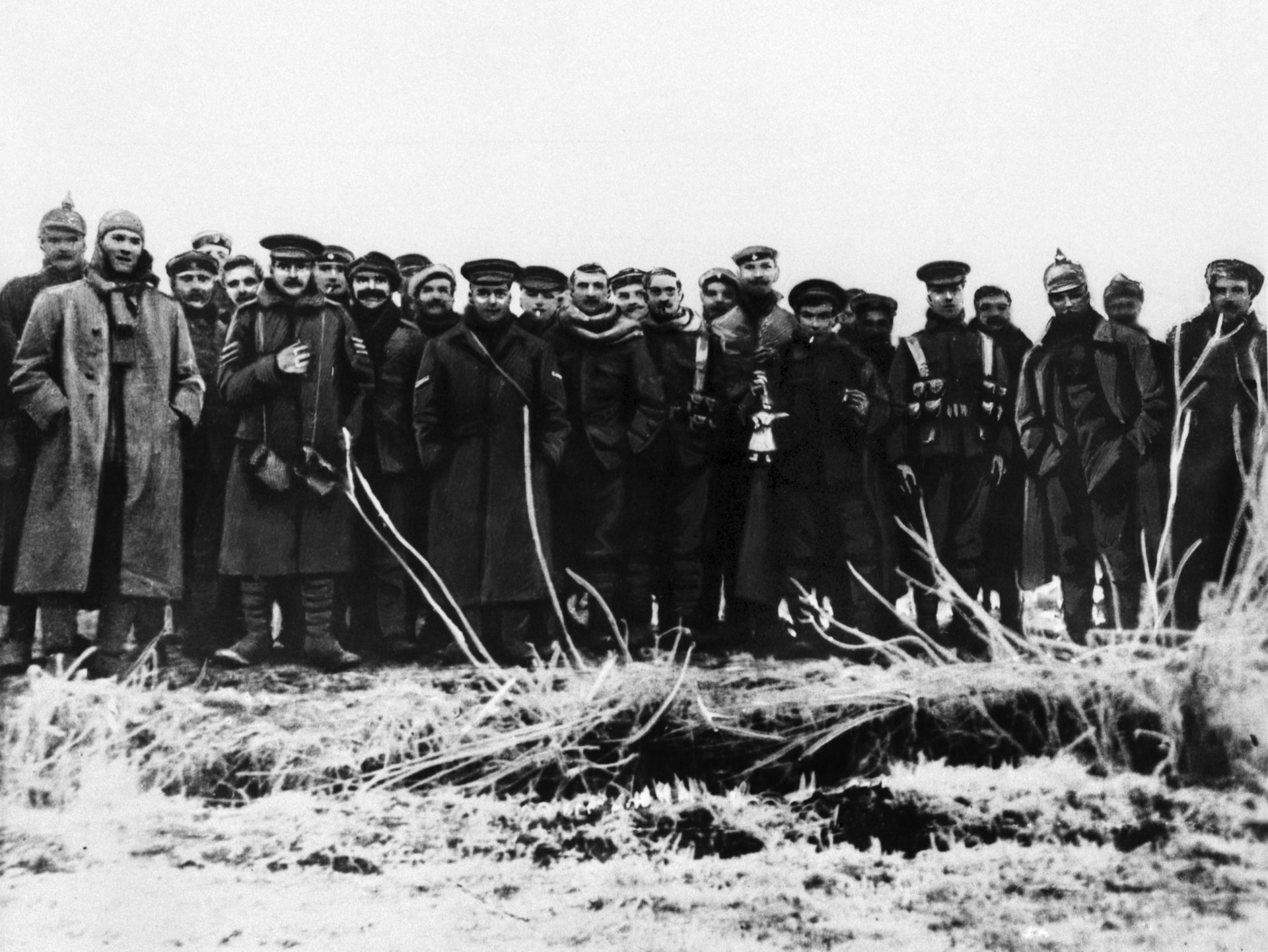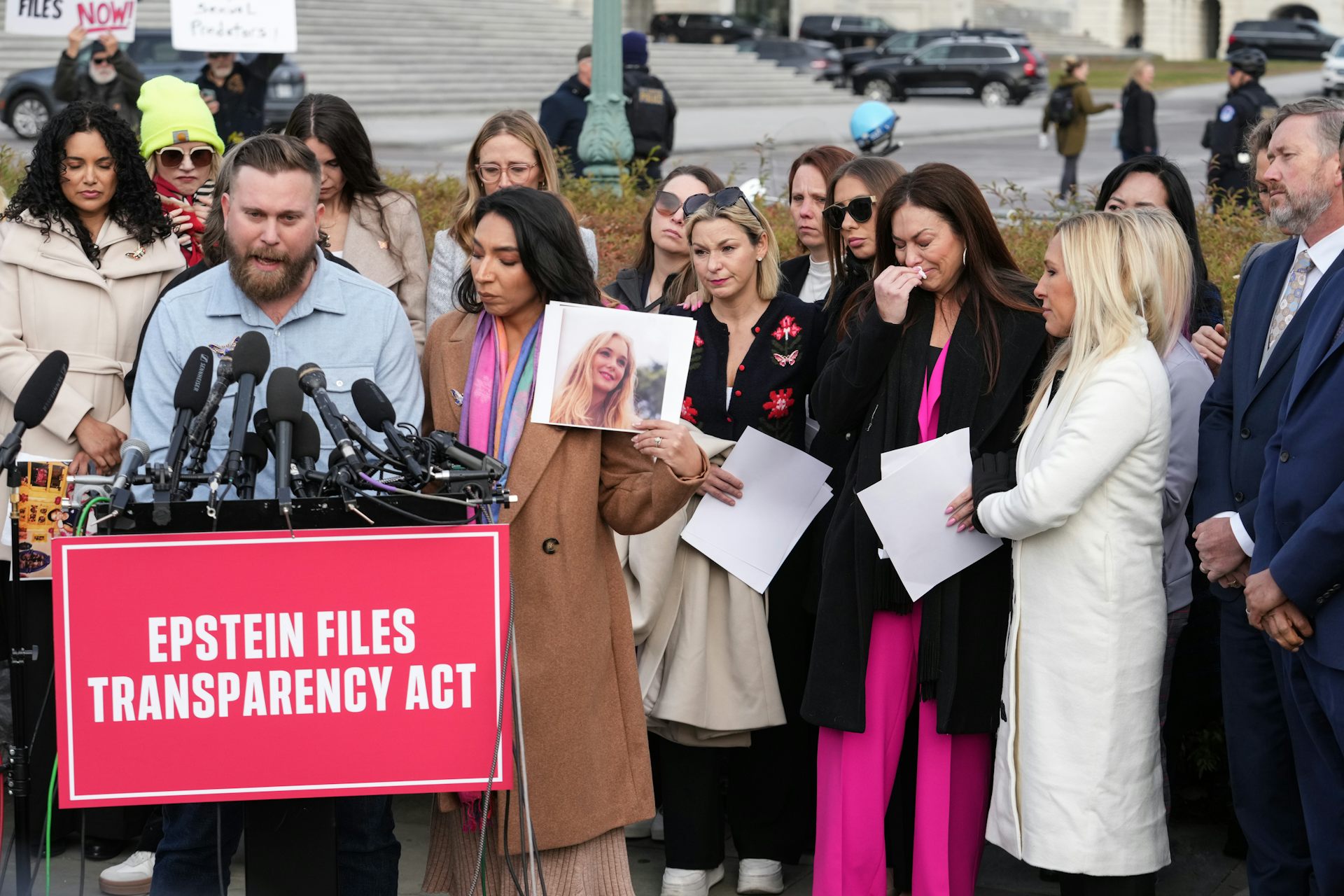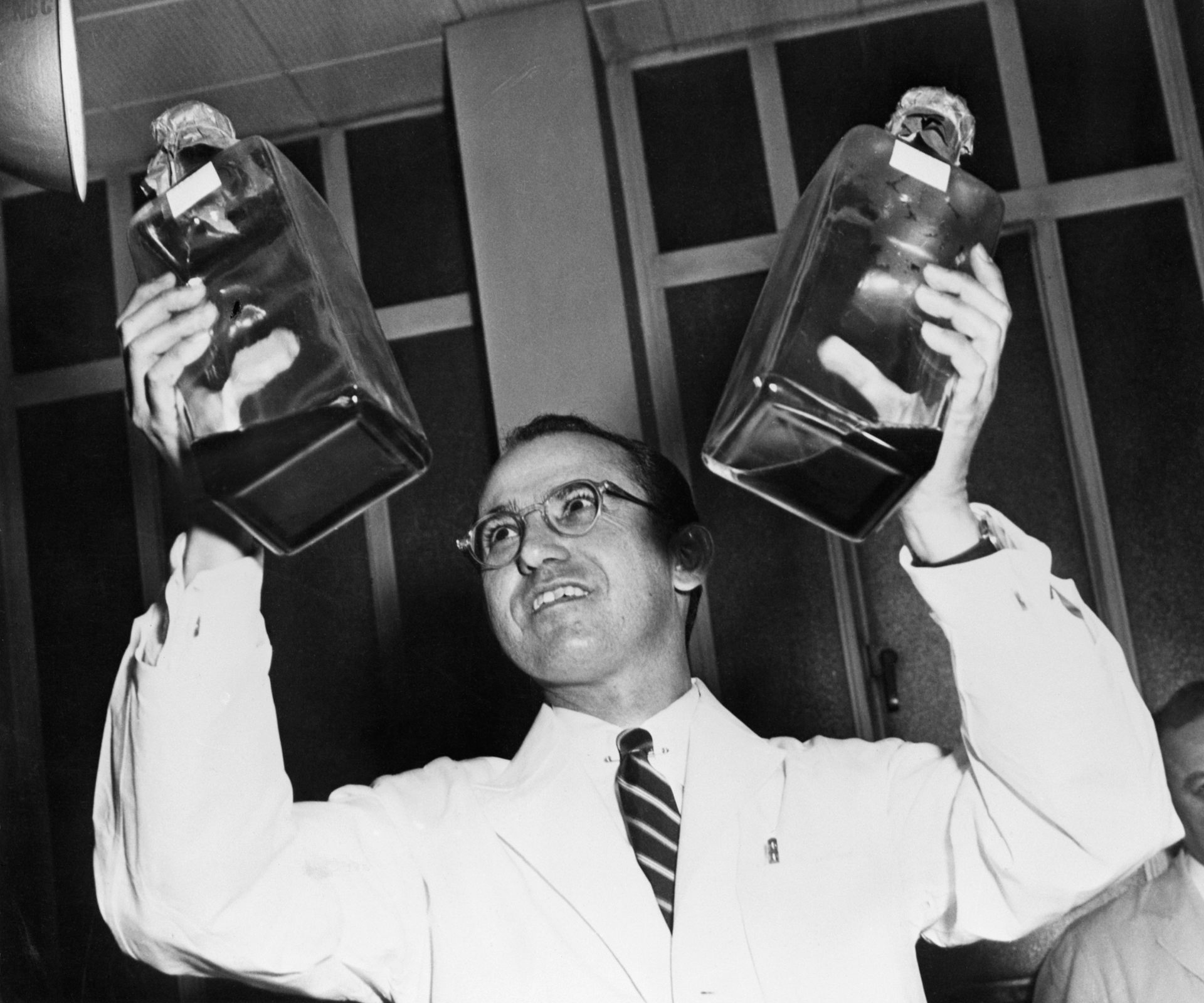'Got polio?' messaging underscores a vaccine campaign's success but creates false sense of security
Polio vaccines have been a massive public health victory in the US. But purely celebratory messaging overlooks the ongoing threat if vaccination rates fall.
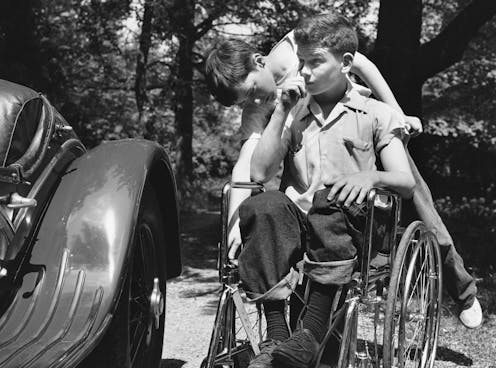
“Got Polio? Me neither. Thanks, Science.”
Messages like this are used in memes, posters, T-shirts and even some billboards to promote routine vaccinations. As this catchy statement reminds people of once-feared diseases of the past, it – perhaps unintentionally – conveys the message that polio has been relegated to the history books.

Phrasing that aims to encourage immunizations by highlighting their accomplishments implies that some diseases are no longer a threat.
Few people today know much about polio. In 2022, only one-third of surveyed adults in the U.S. were aware that polio has no cure. Moreover, a 2020 poll had found that 84% of adults viewed vaccinating children as important, a 10% decline from 2001. The COVID-19 pandemic amplified anti-vaccination messaging, while also delaying routine immunization.
Vaccine-preventable diseases are far from eradicated. Measles outbreaks in unvaccinated or under-vaccinated American communities have begun resurfacing in the past few years, despite a 2000 declaration that the virus had been eliminated in the U.S. Pertussis cases have been on the rise, with more than 18,000 cases reported in 2019. And in July 2022, polio reappeared in an unvaccinated New York man – the first U.S. diagnosis since 1979. This case helped return attention to polio, causing at least some young adults to wonder about their own vaccination status.
A shift in focus to immunization in developing countries has further lulled Americans into a false sense of security. While global approaches have been effective and are certainly needed, as the author of “Constructing the Outbreak: Epidemics in Media and Collective Memory,” I suggest that the celebratory messaging is no longer as effective as it once was and runs the risk of making it seem as if polio only lives in history books.
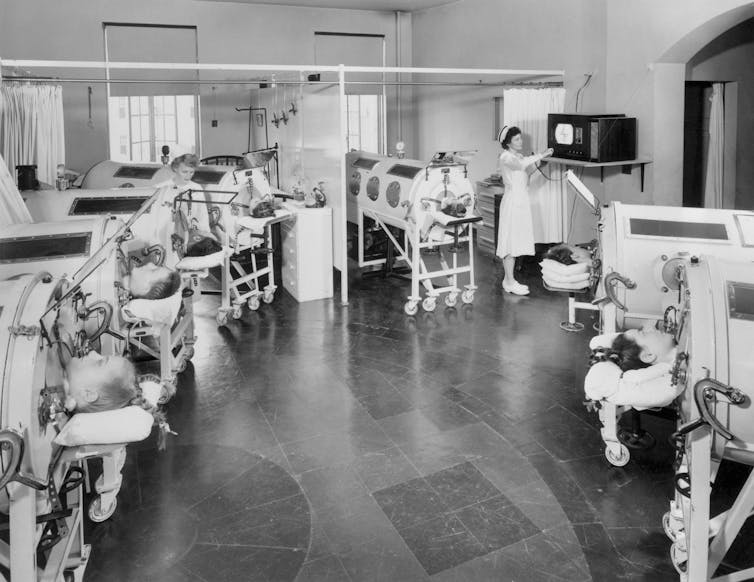
Campaigning against a devastating disease
Before vaccines, polio – called infantile paralysis or poliomyelitis – was the most feared childhood disease in the U.S. Frequently affecting elementary school kids, the disease sometimes presented like a cold or flu – fever, sore throat and headache. In other cases, limb or spinal pain and numbness first indicated that something was wrong. Paralysis of legs, arms, neck, diaphragm or a combination could occur and, depending on the area affected, render patients unable to walk, lift their arms, or breathe outside of an iron lung.
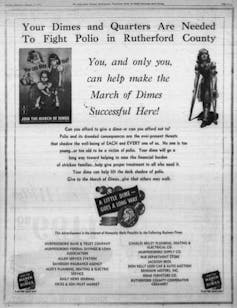
Only time could reveal whether the paralysis was permanent or would recede, sometimes to return decades later as Post-Polio Syndrome. Enough people were infected in outbreaks in the 1930s, 1940s and early 1950s that the effects of paralytic polio were quite visible in everyday life in the form of braces, crutches, slings and other mobility devices.
Thanks to the National Foundation for Infantile Paralysis, beating polio became a national priority. The NFIP grew out of President Franklin Delano Roosevelt’s Warm Springs Foundation. Roosevelt himself had been partially paralyzed by polio, and the NFIP provided funds for public education, research and survivors’ rehabilitation.
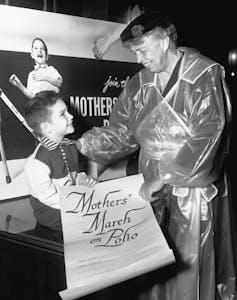
Its campaigns were prolific and diverse, combining interpersonal and mass communication strategies.
From FDR “Birthday Ball” celebrations to parades and elementary school fundraising competitions, various groups raised money. High schoolers performed polio-themed plays, putting the disease itself on trial in “The People vs. Polio.” People passed around collection boxes at movie theaters and other public gatherings.
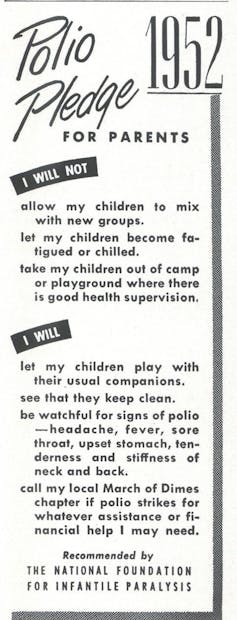
Campaigns used every medium. Brochures and short films raised awareness of the threat of polio, emphasizing the need for funding to support patient rehabilitation and scientific research. The National Foundation for Infantile Paralysis generated scores of radio scripts and hired Frank Sinatra, Elvis Presley and other famous voices to read them. Judy Garland, Mickey Rooney, Lucille Ball and other Hollywood stars also joined the fight. Comic strips and cartoons featuring Mickey Mouse and Donald Duck rallied for March of Dimes funds to help polio patients.
Starting in 1946, the NFIP featured children with crutches and braces who had survived polio as “poster children” asking for funds to help them walk again. News stories covered outbreaks and polio epidemics, detailing the devastation of the disease on individuals, families and communities, while advising families how to reduce risk through the “Polio Pledge for Parents,” which provided a list of do’s and don'ts during summer months.
From public enemy No. 1 to success story
The work of the National Foundation for Infantile Paralysis yielded unprecedented and continuous success, providing hospitals with equipment during epidemics and supporting the development of vaccines. Following the largest vaccine trial in history, on April 12, 1955, the Poliomyelitis Vaccine Evaluation Center announced that Jonas Salk’s vaccine was 80%-90% effective against paralytic polio and officially ready for general use.
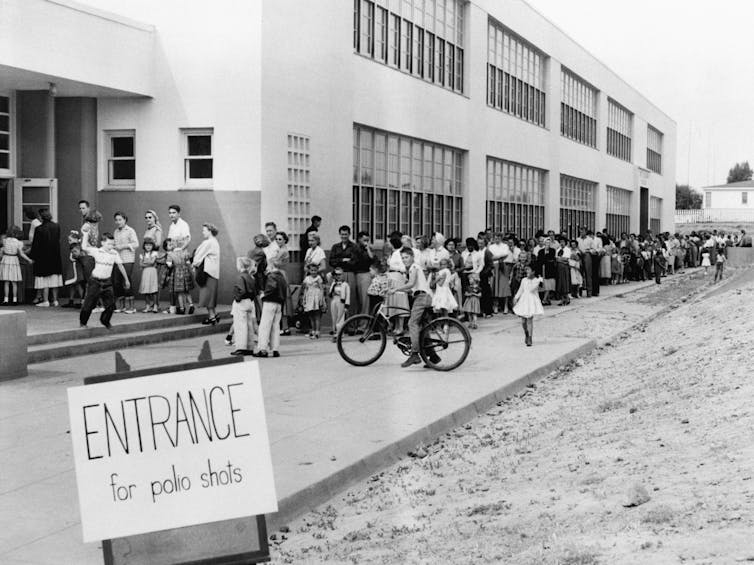
Over the next decade, the NFIP shifted its focus to widespread immunization, again using both mass media and local campaigns. With Salk’s vaccine, and then Albert Sabin’s, polio cases fell quickly, from the peak of 57,879 cases in 1952 to only 72 cases in 1965, with the last naturally occurring U.S. case in 1979.
The repeated declaration of what polio vaccines could and were accomplishing was strategically effective in persuading more people to get their shots. The American public of the 1960s and 1970s had lived through repeated polio epidemics and knew both the fear of contracting the disease and its visible aftereffects. As of 2021, 92.7% of Americans were fully protected by the vaccine, though these rates have been in decline since 2010 and fluctuate by region.
Public health rhetoric that focused on this vaccine success story worked around the world in the late 1980s and 1990s. Gradually, though, the perceived threat in the U.S. of polio and other vaccine-preventable diseases dissipated over generations as vaccinations largely eliminated the risk. Most people in developed countries lack firsthand experiences of just how terrifying these diseases are, having never experienced polio, diphtheria, measles or pertussis, or lost family members to them.
At the same time that polio has been largely forgotten in the U.S., anti-vaccination messages have been spreading disinformation that distorts the risk of vaccines, ignoring the realities of the diseases they immunize against.
Rhetoric from polio vaccine campaigns in the 1950s and 1960s emphasized the risks of not getting immunized – acute illness, life-changing pain and paralysis or even death. In the 21st century U.S., immunization campaigns no longer emphasize these risks, and it’s easy to forget the potentially deadly repercussions of skipping vaccines.
I believe pervasive public health messaging can counter anti-vaccination disinformation. A reminder for the American public about this still dangerous disease can help ensure that “Got Polio?” does not become a serious question.
Katherine A. Foss ne travaille pas, ne conseille pas, ne possède pas de parts, ne reçoit pas de fonds d'une organisation qui pourrait tirer profit de cet article, et n'a déclaré aucune autre affiliation que son organisme de recherche.
Read These Next
From truce in the trenches to cocktails at the consulate: How Christmas diplomacy seeks to exploit s
World leaders like to talk up peace at Christmastime. But alongside the tales of seasonal breaks in…
As DOJ begins to release Epstein files, his many victims deserve more attention than the powerful me
Powerful men connected to Jeffrey Epstein are named, dissected and speculated about. The survivors,…
The world risks forgetting one of humanity’s greatest triumphs as polio nears global eradication − 7
Polio may finally be defeated in the next 5 years. Will the world recognize what an extraordinary achievement…


